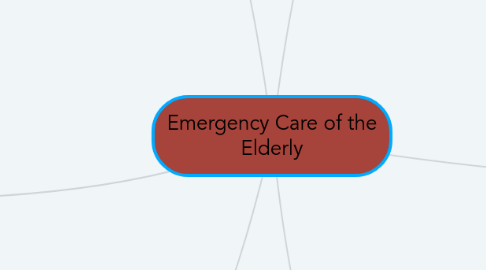
1. Feelings
1.1. Briefly outline your feelings at the time and following the incident
1.1.1. I felt as if this patient was not getting the level of support she required. Due to living alone, even though her family did live nearby.
1.1.2. She did not have carers as she was adamant to remain independent for as long as possible. Did she have capacity to make this decision for herself?
1.1.3. She did have aids to help her with daily life although it was only a walking aid and it was suspected that this is what caused her to fall to begin with. Patient says she tripped over the walking aid whilst making her way to the kitchen. Is the house made safe for her to be living independently at home?
1.1.4. Patient did have a health pendant therefore rang this, carers called family who weren't in the local area at the time therefore called neighbors and they came over to check on the patient. If the patient was in a care home would this have happened?
1.1.5. Neighbors replaced walking aid with pillows to make the wait for an ambulance slightly more comfortable
1.1.6. Patient was extremely happy, cheerful although continued to ask me not to let her die. Emotional distress?
1.1.7. Any ethical issues??
2. Evaluation
2.1. Clearly highlight what went well and what could have gone better (PUNs & PENs). Identify the key themes (usually 1 – 3) you wish to explore from the incident.
2.1.1. PUNs = patient unmet needs
2.1.1.1. Does this patient need more home care? 4 daily visits?
2.1.1.2. Patient has fallen before, she suffers with oedema in her lower legs therefore is unsteady. Why haven't family considered having more than just the health pendant?
2.1.1.3. Patient on the floor for approx. 2 hours before crew arrived. Caused more emotional distress?
2.1.2. PENs = personal educational needs
2.1.2.1. How to respond to the question 'am i going to die?'
2.1.2.2. Should I have submitted a safeguarding review? Due to patient having falls before and nothing has been done to prevent this from happening so often
2.1.3. I believe my assessment of the patient went well as i was able to discover her possible NOF# quickly and therefore was able to handle the patient with care
2.1.3.1. My interpersonal skills had a positive effect on the patients overall experience as she was extremely scared and worried about what was going to happen. I reassured throughout and made her as comfortable as possible, using personal touch as a way of comforting her
2.1.4. 3 main points from the incident
2.1.4.1. Frailty and Falls in the elderly
2.1.4.2. The benefits of having home care
2.1.4.3. Safeguarding of the elderly
3. Analysis of the themes
3.1. Make your point: did this patient have the level of care she required in association with her health? Did the family take into consideration her home and the level of aids around? Why haven't any other crews who have been to the patient put in a safeguarding?
3.2. Support this with evidence from your research: RESEARCH ARTICLES!!!!!!
3.2.1. How reliable is the research? Is there other research that supports it or reached alternative findings? (critique the evidence)
3.3. Take a view based on your findings and relate this back to your case study / future practice
4. Introduction
4.1. Issues of the ageing population
4.1.1. By 2045 this is projected to reach 25% which is a significant increase in those over 80 years of age
4.1.2. The amount of time spent needing daily care at the end of life has doubled in England over the past two decades
4.1.3. Ambulance clinicians face a number of challenges when responding to older people especially those living alone or cognitively impaired
4.2. Literature Review
4.2.1. Outline your literature review strategy
4.2.1.1. CINAHL plus
4.2.1.1.1. Using key words such as emergency care, elderly, ageing population, older adults and pre-hospital allow me to find relevant articles and studies associated with the topic focus
4.2.1.1.2. Using the advances search, I can find articles that are focused only on the emergency care of the elderly or the ageing population and the successes and struggles these propose
4.3. Reflective Model used
4.3.1. I.F.E.A.R. Smart (2011) adapted from Gibbs
4.3.1.1. Incident description, Feelings, Evaluation, Analysis, and Reaction & response
5. Incident / case description
5.1. 93 year-old female Fallen, unable to stand, pain in her right side
5.1.1. Assessed patients hip, obvious deformity. ?NOF#
5.1.2. Patient led on back, neighbors found her on the floor after she went to make herself a cup of tea, known to have frailty / deterioration in her mobility. Uses a walking aid however her leg gave way and she fell on top of the walking aid. Patient ended up with her neck balanced on the aid. Neighbors replaced the walking aid with a pillows. On arrival patient still on the floor, in obvious discomfort. Hypotension, although all other observations normal. On secondary survey, obvious deformity to right hip with internal rotation of her right leg. Pain on palpation. No other obvious injuries
5.1.2.1. Initially refused pain relief however on using the scoop to transfer onto the stretcher, she began to cry due to the pain, IV paracetamol administered on route to ED
5.1.3. In emotional distress, asking if she was going to die, saying she didn't want to die.
